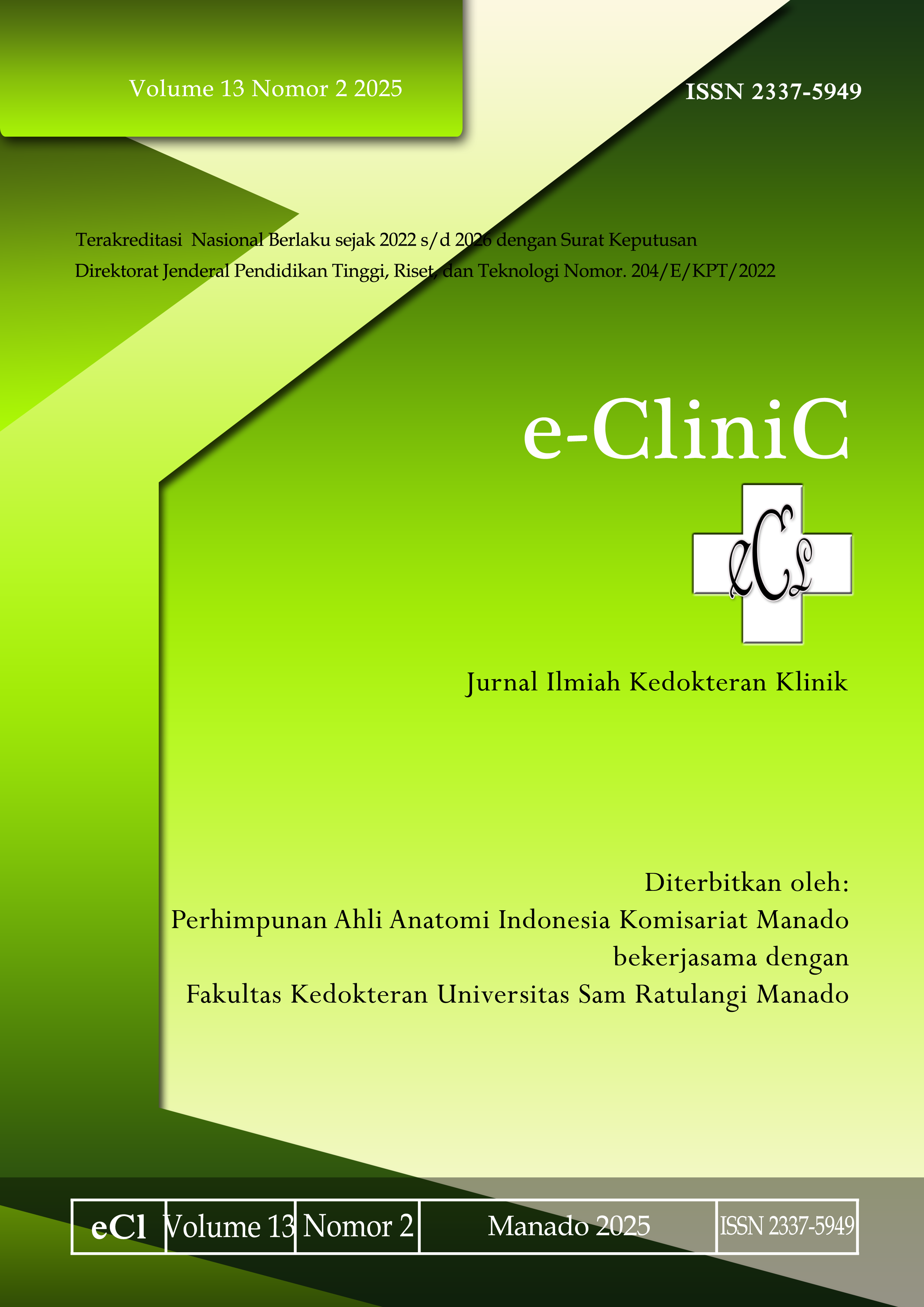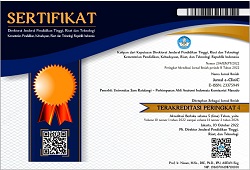Long-Term Follow-up after Kidney Trauma at Prof. Dr. R. D. Kandou General Hospital Manado
DOI:
https://doi.org/10.35790/ecl.v13i2.59605Abstract
Abstract: Renal trauma, caused by blunt or penetrating injuries, is associated with severe complications such as hypertension, chronic kidney disease (CKD), and pyelonephritis, especially in high-grade renal trauma. The study aimed to evaluate the complications and management of renal trauma patients at Prof. Dr. R. D. Kandou Hospital Manado from January 2022 to October 2024. This was an observational study with a cross-sectional design involving 17 patients that met the inclusion criteria. Data included types of trauma, severity level, management approaches, and post-trauma complications. Trauma severity was classified using the American Association for Surgery of Trauma (AAST) grading system. The results showed that 58.8% of patients had penetrating trauma, while 41.2% experienced blunt trauma. The highest percentages were found in grade II severity (29.4%). Operative management was the most common approach (58.8%). Post-trauma complications included CKD (70.5%), hypertension (29.4%), and pyelonephritis (29.4%). In conclusion, renal trauma, whether blunt or penetrating, often leads to significant complications such as CKD and hypertension. Proper long-term management and monitoring of kidney function and blood pressure are crucial to minimize the complications. This study highlights the need for early and effective intervention in high-grade renal trauma cases.
Keywords: renal trauma; hypertension; acute kidney injury (AKI); chronic kidney disease (CKD); post-trauma complications
References
Lynch T, Martinez-Pineiro L, Plas E, Serafetinides E, Turkeri L, Santucci R, et al. EAU guidelines on urological trauma. Eur Urol. 2005;47(1):1–15. Doi: 10.1016/j.eururo.2004.07.028
Singh S, Sookraj K. Kidney trauma. [Updated 2023 Jul 17]. In: StatPearls [Internet]. Treasure Island (FL): StatPearls Publishing; 2024 Jan-. Available from: https://www.ncbi.nlm.nih.gov/books/NBK532896/
Gampo CE, Irdam A, Soebadi A, Kuncoro P, Parardya AA, Agil A, et al. Pocket Guideline Trauma Urogenital (1st ed). Jakarta: Ikatan Ahli Urologi Indonesia; 2022.
Erlich T, Kitrey ND. Renal trauma: the current best practice. Ther Adv Urol. 2018;10(10):295–303. Doi: 10.1177/1756287218785828.
Park SJ, Kim JK, Kim KW, Cho KS. MDCT Findings of Renal Trauma. AJR Am J Roentgenol. 2006;187(2):541–7. Doi: 10.2214/AJR.05.0543.
Kidney Disease: Improving Global Outcomes (KDIGO) CKD Work Group. KDIGO 2024 Clinical Practice Guideline for the Evaluation and Management of Chronic Kidney Disease. Kidney Int. 2024;105(4S): S117–S314. Available from: https://doi.org/10.1016/j.kint.2023.10.018
Lai W-H, Rau C-S, Wu S-C, Chen Y-C, Kuo P-J, Hsu S-Y, et al. Post-traumatic acute kidney injury: a cross-sectional study of trauma patients. Scand J Trauma Resusc Emerg Med. 2016;24(1):136. Doi: 10.1186/s12245-023-00569-y
Bihorac A, Delano MJ, Schold JD, Lopez MC, Nathens AB, Maier RV, et al. Incidence, Clinical Predictors, Genomics, and Outcome of Acute Kidney Injury Among Trauma Patients. Ann Surg. 2010;252(1):158–65. doi: 10.1097/SLA.0b013e3181deb6bc
Lee K, Ryu D, Kim H, Park S, Lee S, Park C, et al. Selection of appropriate reference creatinine estimate for acute kidney injury diagnosis in patients with severe trauma. Acute Crit Care. 2023;38(1):95–103. Doi: 10.4266/acc.2022.01046
Venkatachalam MA, Griffin KA, Lan R, Geng H, Saikumar P, Bidani AK. Acute kidney injury: a springboard for progression in chronic kidney disease. Am J Physiol Renal Physiol. 2010;298(5):F1078–94. Doi: 10.1152/ajprenal.00017.2010
Coca SG, Singanamala S, Parikh CR. Chronic kidney disease after acute kidney injury: a systematic review and meta-analysis. Kidney Int. 2012 May;81(5):442–8. Doi: 10.1038/ki.2011.379.
Hsu RK, Hsu CY. The role of acute kidney injury in chronic kidney disease. Semin Nephrol. 2011;31(4):283–92. Doi: 10.1016/j.semnephrol.2016.05.005
Chawla LS, Eggers PW, Star RA, Kimmel PL. Acute kidney injury and chronic kidney disease as interconnected syndromes. N Engl J Med. 2014;371(1):58–66. Doi: 10.1056/NEJMra1214243
Nitta K, Schrier RW. Hypertension as a risk factor for the progression of chronic kidney disease. Curr Opin Nephrol Hypertens. 2013;22(1):2–8. Available from: https://doi.org/10.1161/CIRCRESAHA.122.321762
Hickler RB. Hypertensive emergency: a useful diagnostic category. Am J Public Health. 1988;78(6):623-4. Doi:10.2105/ajph.78.6.623
Downloads
Published
How to Cite
Issue
Section
License
Copyright (c) 2025 Eko Arianto, Bryan P. Panelewen, Ari Astram, Christof Toreh, Frendy Wihono

This work is licensed under a Creative Commons Attribution-NonCommercial 4.0 International License.
COPYRIGHT
Authors who publish with this journal agree to the following terms:
Authors hold their copyright and grant this journal the privilege of first publication, with the work simultaneously licensed under a Creative Commons Attribution License that permits others to impart the work with an acknowledgment of the work's origin and initial publication by this journal.
Authors can enter into separate or additional contractual arrangements for the non-exclusive distribution of the journal's published version of the work (for example, post it to an institutional repository or publish it in a book), with an acknowledgment of its underlying publication in this journal.
Authors are permitted and encouraged to post their work online (for example, in institutional repositories or on their website) as it can lead to productive exchanges, as well as earlier and greater citation of the published work (See The Effect of Open Access).







